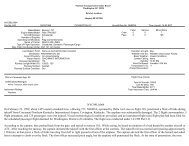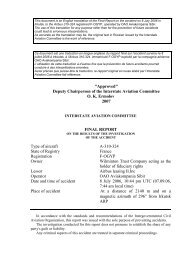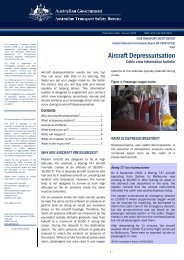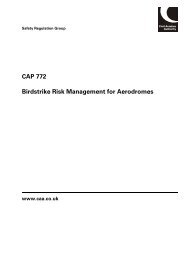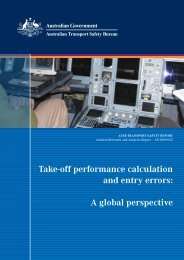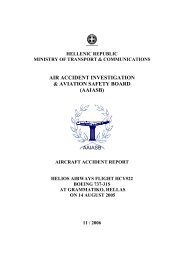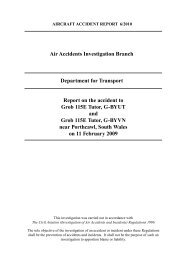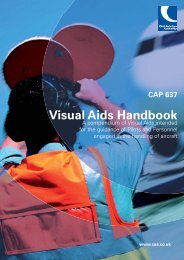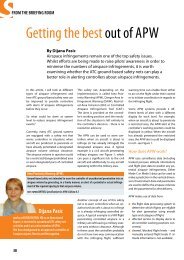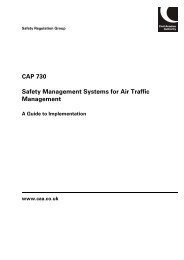Altitude Deviation or Level Bust What's in a name? - SKYbrary
Altitude Deviation or Level Bust What's in a name? - SKYbrary
Altitude Deviation or Level Bust What's in a name? - SKYbrary
You also want an ePaper? Increase the reach of your titles
YUMPU automatically turns print PDFs into web optimized ePapers that Google loves.
FROM THE BRIEFING ROOM<br />
28<br />
<strong>Altitude</strong> <strong>Deviation</strong> <strong>or</strong> <strong>Level</strong> <strong>Bust</strong><br />
What’s <strong>in</strong> a <strong>name</strong>?<br />
There are several problematic issues when expl<strong>or</strong><strong>in</strong>g why<br />
these events happen. By Anne Isaac, NATS, UK<br />
The first is often that <strong>or</strong>ganisations classify<br />
them as adverse event outcomes,<br />
rather than exam<strong>in</strong><strong>in</strong>g the many causal<br />
elements which should be considered as<br />
lead<strong>in</strong>g to these events; <strong>in</strong> other w<strong>or</strong>ds<br />
a level bust <strong>or</strong> altitude deviation is the<br />
outcome of several adverse <strong>or</strong> erroneous<br />
activities, not the effect. How an <strong>or</strong>ganisation<br />
views these events may well dictate<br />
what is learnt and ultimately what<br />
mitigations are developed.<br />
The second, rather m<strong>or</strong>e subtle issue<br />
concerns the w<strong>or</strong>ld view adopted by the<br />
pilots and the controllers, s<strong>in</strong>ce these are<br />
typically the only players <strong>in</strong> this 3 dimensional<br />
game. An ATCO’s w<strong>or</strong>ld view<br />
is based on a fast mov<strong>in</strong>g, dynamic sequence<br />
of multiple targets, all of which<br />
are imp<strong>or</strong>tant <strong>in</strong> their controll<strong>in</strong>g strategy<br />
– it is f<strong>or</strong> this reason that the maj<strong>or</strong>ity<br />
take level bust events extremely seriously.<br />
The potential f<strong>or</strong> several of their<br />
multiple targets be<strong>in</strong>g 300 feet from<br />
their assigned level is not only a risk, but<br />
<strong>in</strong>creases their w<strong>or</strong>kload <strong>in</strong>crementally.<br />
In contrast a flight crew’s w<strong>or</strong>ld view is<br />
focussed on their own aircraft and its<br />
crew, passengers and cargo, effectively<br />
and safely arriv<strong>in</strong>g at the dest<strong>in</strong>ation<br />
without stray<strong>in</strong>g <strong>in</strong>to uncontrolled airspace<br />
and gett<strong>in</strong>g too close to build<strong>in</strong>gs,<br />
high ground and other vehicles<br />
and aircraft. Theref<strong>or</strong>e deviat<strong>in</strong>g by 300<br />
feet from an assigned level is possibly<br />
considered just that – an altitude<br />
deviation, and if there was little<br />
chance of gett<strong>in</strong>g close to another<br />
aircraft, their perceived risk is<br />
low. Discussions with many airl<strong>in</strong>es<br />
would re<strong>in</strong>f<strong>or</strong>ce that many<br />
of these deviations, although<br />
undesirable, are usually not<br />
high on the safety risk register.<br />
It is f<strong>or</strong> this reason that we may<br />
have a rather larger problem to<br />
fix than the elements which lead<br />
to these undesired events.<br />
Thus far it has been tempt<strong>in</strong>g, and often<br />
just pla<strong>in</strong> practical, to try and tackle<br />
these events from either the pilot <strong>or</strong><br />
controller’s po<strong>in</strong>t of view; rarely do we<br />
seem to try and get a ‘holistic’ w<strong>or</strong>ld<br />
view which takes <strong>in</strong>to account the tasks<br />
and requirements of both professional<br />
groups. Clearly both groups are subject<br />
to similar human perf<strong>or</strong>mance limita-<br />
tions and theref<strong>or</strong>e it is not surpris<strong>in</strong>g<br />
that these events happen with predictable<br />
regularity. There have also been<br />
many learned rep<strong>or</strong>ts and research<br />
papers detail<strong>in</strong>g the causal fact<strong>or</strong>s of<br />
these events and lots of sound advice<br />
to help both ATCOs and pilots to avoid<br />
these situations. Many of these are familiar<br />
to us all:<br />
n Altimeter sett<strong>in</strong>g err<strong>or</strong>s<br />
n Distractions – <strong>in</strong> the ops room <strong>or</strong> on<br />
the flight-deck<br />
n Mishandl<strong>in</strong>g of the FMS<br />
n C<strong>or</strong>rect pilot readback followed by<br />
<strong>in</strong>c<strong>or</strong>rect action<br />
n An <strong>in</strong>c<strong>or</strong>rect and unchallenged controller<br />
<strong>in</strong>struction<br />
n An unchallenged <strong>in</strong>c<strong>or</strong>rect pilot<br />
readback<br />
The list is lengthy and typically partitions<br />
the responsibility to one <strong>or</strong> other<br />
professional group; so what could we<br />
learn if we took an approach which<br />
considered that these events were the<br />
result of simultaneous and consecutive<br />
err<strong>or</strong> cha<strong>in</strong>s?<br />
Some years ago, there was just such an<br />
opp<strong>or</strong>tunity to look at situations that<br />
were associated with this type of event<br />
from both sides of the radio/telephony,<br />
with the follow<strong>in</strong>g results 1 .<br />
From an ATC perspective, <strong>in</strong>cidents<br />
regard<strong>in</strong>g level busts were associated<br />
with plann<strong>in</strong>g, co<strong>or</strong>d<strong>in</strong>ation and communication.<br />
From the flight deck, err<strong>or</strong>s<br />
that resulted <strong>in</strong> altitude deviations<br />
were associated with mis-handl<strong>in</strong>g,<br />
mode sett<strong>in</strong>g, communication and<br />
navigation.
Both sets of err<strong>or</strong>s were categ<strong>or</strong>ised at<br />
a high level as either a human <strong>in</strong>f<strong>or</strong>mation<br />
process<strong>in</strong>g err<strong>or</strong> (<strong>in</strong>clud<strong>in</strong>g decision-mak<strong>in</strong>g,<br />
plann<strong>in</strong>g and execution),<br />
communication <strong>or</strong> an equipment<br />
malfunction. 2<br />
Err<strong>or</strong> types<br />
Human <strong>in</strong>f<strong>or</strong>mation<br />
Process<strong>in</strong>g Err<strong>or</strong><br />
Communication<br />
Equipment Malfunction<br />
Results <strong>in</strong>dicated that the ma<strong>in</strong> problems<br />
f<strong>or</strong> both professional groups<br />
were associated with <strong>in</strong>f<strong>or</strong>mation<br />
process<strong>in</strong>g. F<strong>or</strong> the ATCO it was <strong>in</strong> the<br />
monit<strong>or</strong><strong>in</strong>g and process<strong>in</strong>g of clearances.<br />
F<strong>or</strong> the pilots the issues were<br />
associated with execut<strong>in</strong>g a plan and<br />
fly<strong>in</strong>g that profile. In terms of communication,<br />
both groups demonstrated<br />
err<strong>or</strong>s <strong>in</strong> the giv<strong>in</strong>g and receiv<strong>in</strong>g of<br />
clearances, and <strong>in</strong> monit<strong>or</strong><strong>in</strong>g compliance.<br />
The flight crews tended to have<br />
m<strong>or</strong>e robust cross check<strong>in</strong>g built <strong>in</strong><br />
to their SOPs, which possibly allowed<br />
these err<strong>or</strong>s to be managed m<strong>or</strong>e effectively.<br />
Hav<strong>in</strong>g established the common err<strong>or</strong><br />
types, extensive further w<strong>or</strong>k was<br />
done by monit<strong>or</strong><strong>in</strong>g on the flight<br />
deck and <strong>in</strong> the ATC operational environment<br />
to establish the nature of<br />
simultaneous err<strong>or</strong> lead<strong>in</strong>g to these<br />
level bust/altitude deviation events.<br />
It was established that both w<strong>or</strong>k<strong>in</strong>g<br />
environments could be degraded <strong>in</strong><br />
n<strong>in</strong>e ways which could lead to three<br />
1- this research was undertaken <strong>in</strong> new Zealand<br />
2- this categ<strong>or</strong>isation was established <strong>in</strong> <strong>or</strong>der to<br />
compare the flight-deck elements with the atC<br />
elements and would not reflect today’s m<strong>or</strong>e<br />
advanced approaches<br />
H<strong>in</strong>dsight 10 W<strong>in</strong>ter 2010<br />
problems; risk acceptance (associated<br />
with assumptions), out of the loop<br />
(associated with situation awareness)<br />
and high stress levels (associated with<br />
w<strong>or</strong>kload and uncerta<strong>in</strong>ty). The n<strong>in</strong>e<br />
situations can be listed as follows:<br />
Flight-deck err<strong>or</strong>s<br />
14<br />
5<br />
1<br />
ops. room err<strong>or</strong>s<br />
66<br />
24<br />
1<br />
n Risk acceptance due to (1) mutual<br />
confidence and underestimat<strong>in</strong>g<br />
risk;<br />
n Out of the loop lead<strong>in</strong>g to <strong>or</strong> caused<br />
by (2) overload, (3) b<strong>or</strong>edom, (4)<br />
preoccupation and (5) <strong>in</strong>experience/<br />
(6)over experience;<br />
n Stress levels caused by (7) task overload,<br />
(8) unfamiliar situations and<br />
(9) surprise.<br />
In this w<strong>or</strong>k it was also established that<br />
err<strong>or</strong>s usually occurred dur<strong>in</strong>g the first<br />
15 m<strong>in</strong>utes of an ATCO’s shift and, <strong>in</strong><br />
comparison, the maj<strong>or</strong>ity of flight-deck<br />
err<strong>or</strong>s occurred <strong>in</strong> the first AND last 15<br />
m<strong>in</strong>utes of the flight. This may be due<br />
Edit<strong>or</strong>ial Comment<br />
Anne observes that the maj<strong>or</strong>ity of<br />
flight deck err<strong>or</strong>s found <strong>in</strong> the level<br />
bust research she quoted occurred<br />
<strong>in</strong> the first and last fifteen m<strong>in</strong>utes<br />
of a flight and speculated as to why<br />
this might be so. We asked an experienced<br />
airl<strong>in</strong>e capta<strong>in</strong> what they<br />
thought and there was no doubt – it<br />
was the comb<strong>in</strong>ation of higher w<strong>or</strong>kload<br />
and the greater rate of vertical<br />
re-clearance which typically charac-<br />
FROM THE BRIEFING ROOM<br />
Anne Isaac<br />
leads the Human Perf<strong>or</strong>mance development w<strong>or</strong>k <strong>in</strong><br />
the pilot/controller <strong>in</strong>terface <strong>in</strong> NATS, UK.<br />
She ga<strong>in</strong>ed her PhD <strong>in</strong> Cognitive Neuropsychology at<br />
Otago University <strong>in</strong> New Zealand. Her previous w<strong>or</strong>k has<br />
been <strong>in</strong> the development of <strong>in</strong>cident <strong>in</strong>vestigation tools<br />
and techniques <strong>in</strong> European ATM,<br />
the <strong>in</strong>troduction of TRM <strong>in</strong>to the ATC<br />
environment and the <strong>in</strong>troduction of<br />
Day to Day Safety Surveys techniques<br />
<strong>in</strong>to NATS. She has written several<br />
book chapters, academic papers<br />
and the book Air Traffic Control:<br />
the human perf<strong>or</strong>mance fact<strong>or</strong>s.<br />
to the differences <strong>in</strong> the distribution of<br />
w<strong>or</strong>kload, <strong>or</strong> <strong>in</strong> the way the flight-deck<br />
crews and controll<strong>in</strong>g teams divide their<br />
tasks and responsibilities.<br />
Typically, such research activity starts to<br />
expla<strong>in</strong> the mutual reliance which one<br />
professional group has on the other and<br />
the need f<strong>or</strong> them to better collab<strong>or</strong>ate <strong>in</strong><br />
lesson learn<strong>in</strong>g. It is clear that until each<br />
side of the R/T understands how the other<br />
views these events - as altitude deviations<br />
<strong>or</strong> as level busts - and what we can collectively<br />
do to reduce the risk, we may still be<br />
writ<strong>in</strong>g about the subject <strong>in</strong> another 15<br />
years! I hope not, s<strong>in</strong>ce it has been proved<br />
that f<strong>or</strong> every level bust that is rep<strong>or</strong>ted<br />
there are 40 ‘altitude deviations’ which are<br />
not – so what is <strong>in</strong> a <strong>name</strong>?<br />
terised both the <strong>in</strong>itial climb and the<br />
<strong>in</strong>termediate and f<strong>in</strong>al approach. Our<br />
capta<strong>in</strong> then went on to speculate <strong>in</strong><br />
turn by suggest<strong>in</strong>g that perhaps the<br />
prevalence of <strong>in</strong>creased ATCO err<strong>or</strong><br />
rates dur<strong>in</strong>g the first 15 m<strong>in</strong>utes of<br />
their shift was a consequence of the<br />
higher w<strong>or</strong>kload that must typify the<br />
first sect<strong>or</strong> takeover. He also agreed<br />
with Anne’s po<strong>in</strong>t about the effect of<br />
the different focus of flight crew compared<br />
to controllers on the perceived<br />
‘imp<strong>or</strong>tance’ of level busts… n<br />
29





